Abstract
This study was conducted to investigate a possible etiological role of chlorinated hydrocarbons in the pathogenesis of repeated miscarriages. The blood levels of chlorinated hydrocarbons [CHCs: pentachlorophenol, hexachlorocyclohexane, hexachlorobenzene, the dichlorodiphenyltrichloroethane (DDT) group, polychlorinated biphenyls] were determined in 89 women with repeated miscarriages, who were referred to the University Hospital of Obstetrics and Gynecology of Heidelberg for investigations between 1989 and 1993, and compared to a previously investigated reference population. In more than 20% of the women, at least one of the CHC levels exceeded the reference range. CHC levels did not differ significantly between women with primary or secondary and early or late miscarriages; neither did they differ between women with hormonal or immunological disorders as causes of repeated miscarriages or women with idiopathic repeated miscarriages. No significant associations were detected between CHC levels and further conceptions or the outcome of further pregnancies. As significant associations were found between increasing CHC blood concentrations and immunological and hormonal changes, CHCs may have an impact on the pregnancy course in certain cases.
Full text
PDF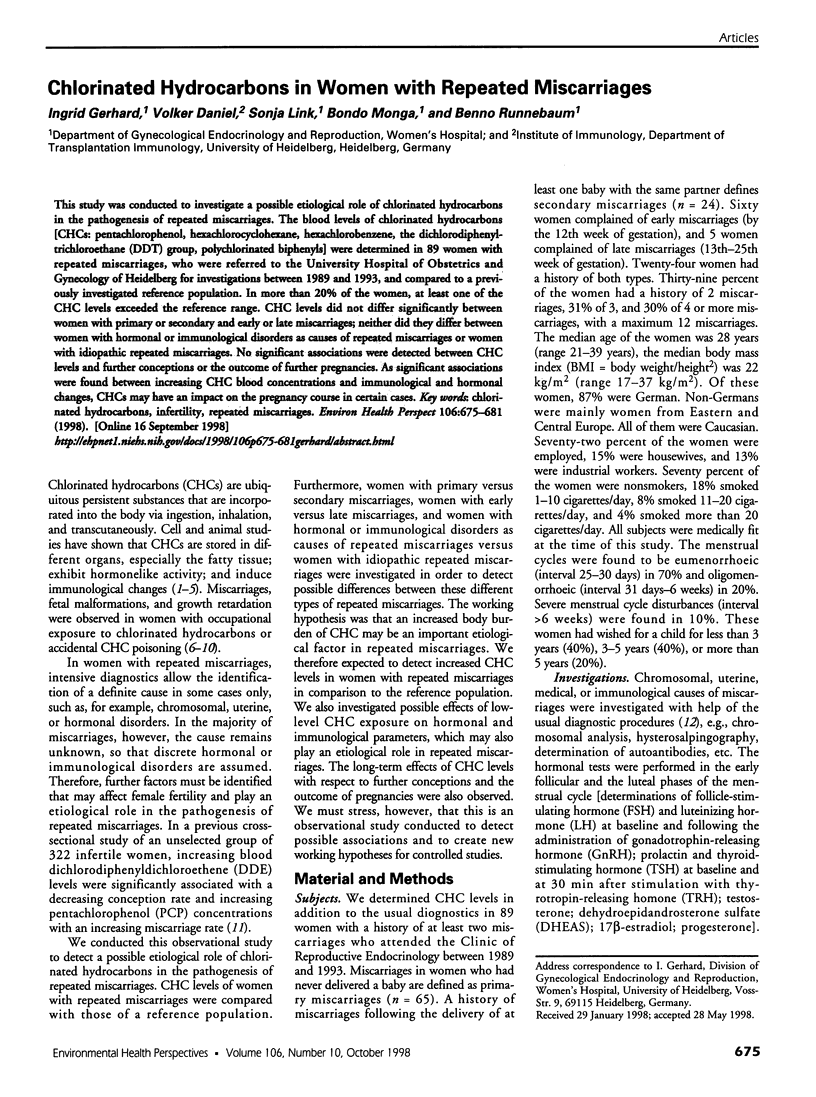
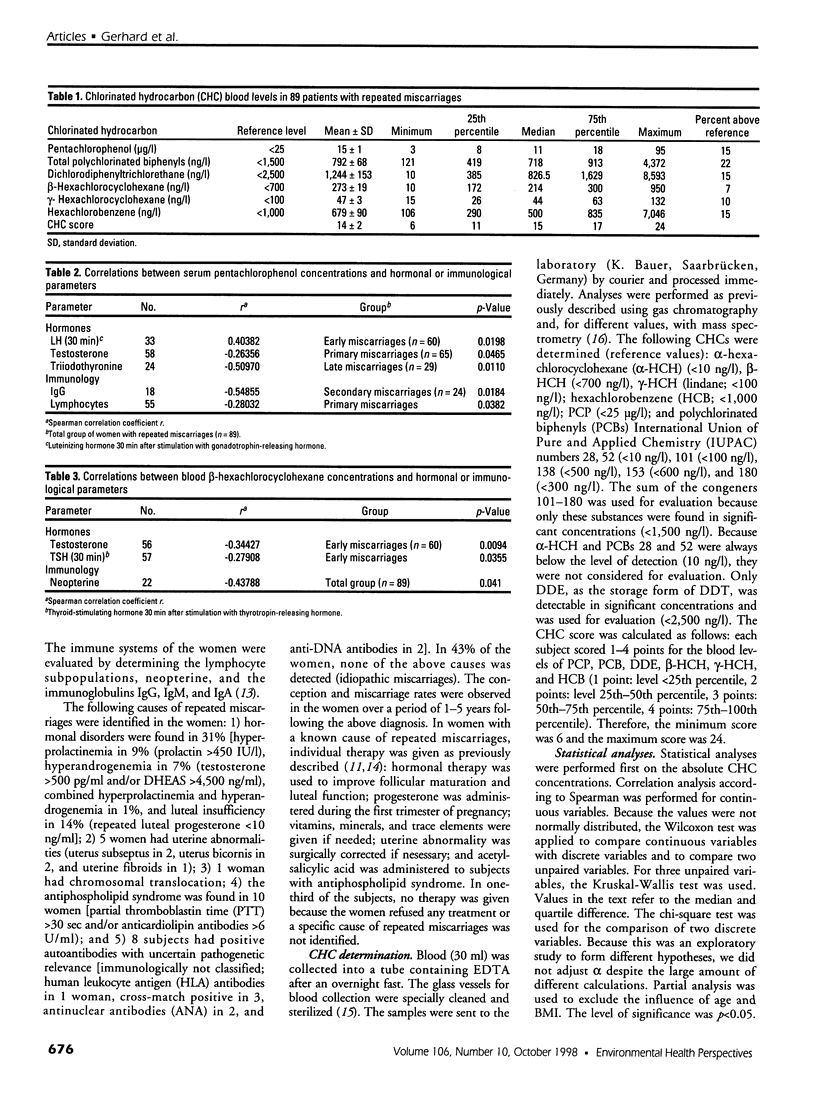
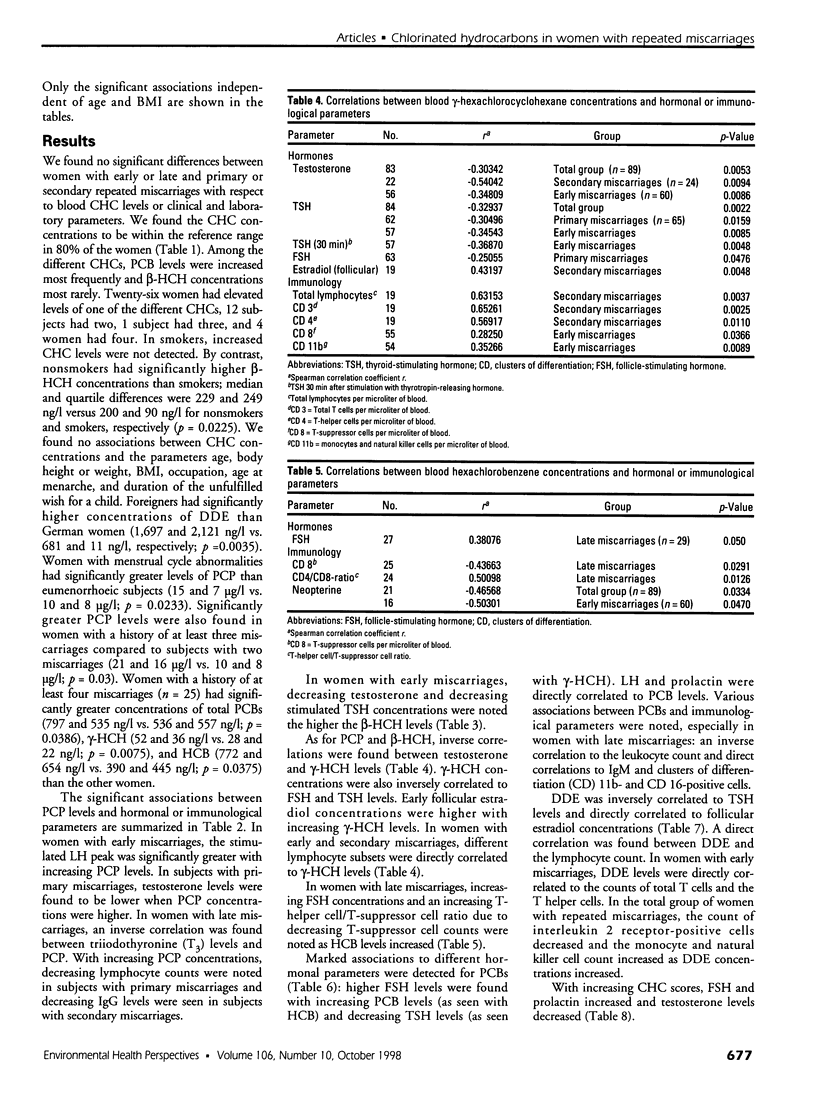
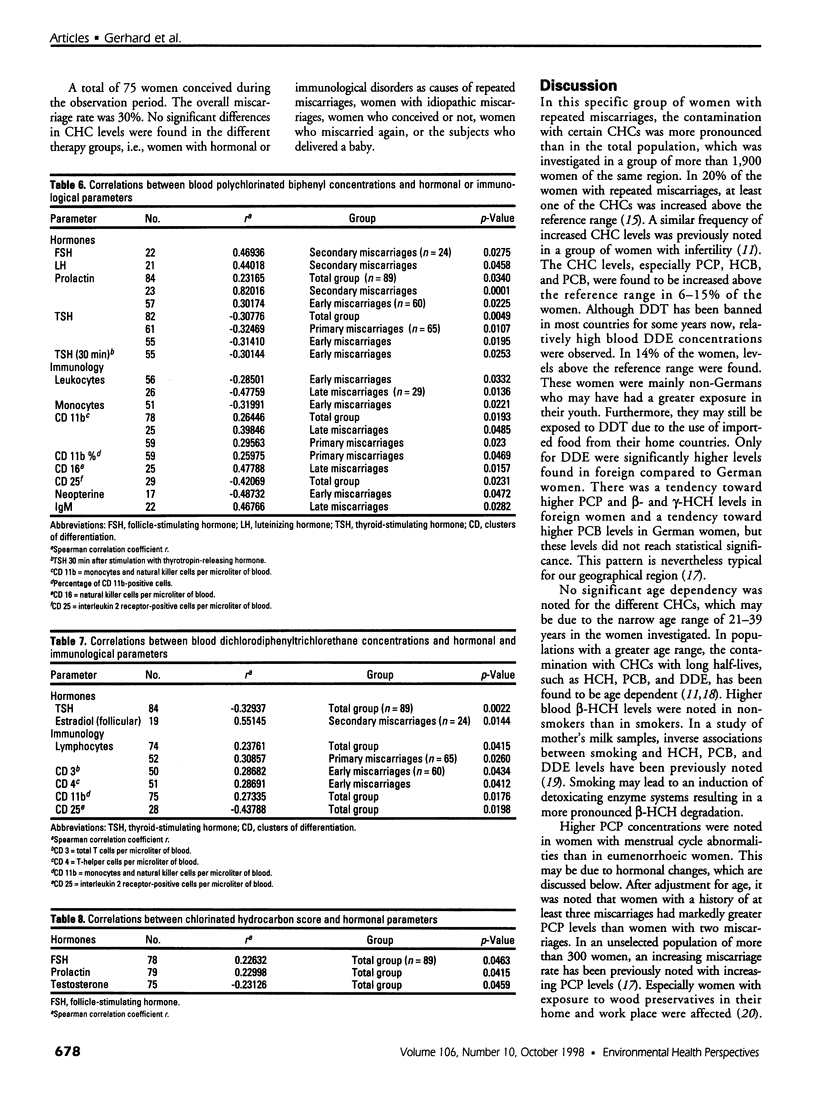
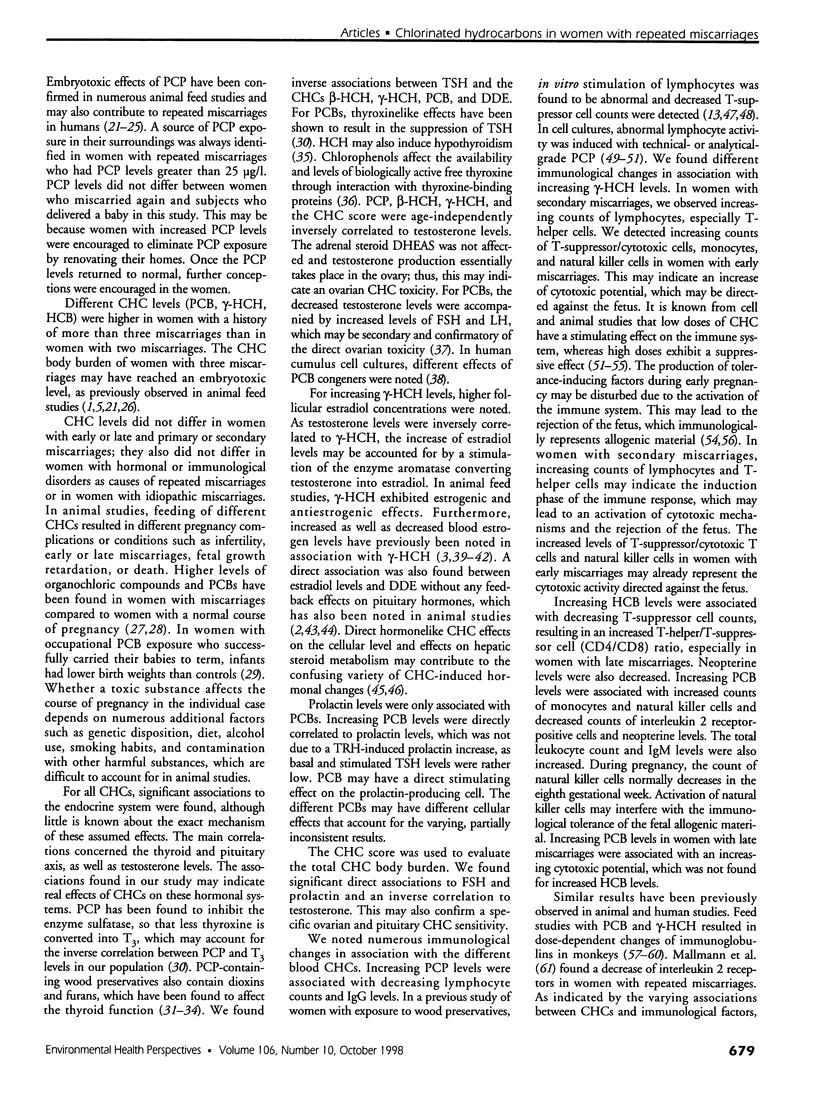
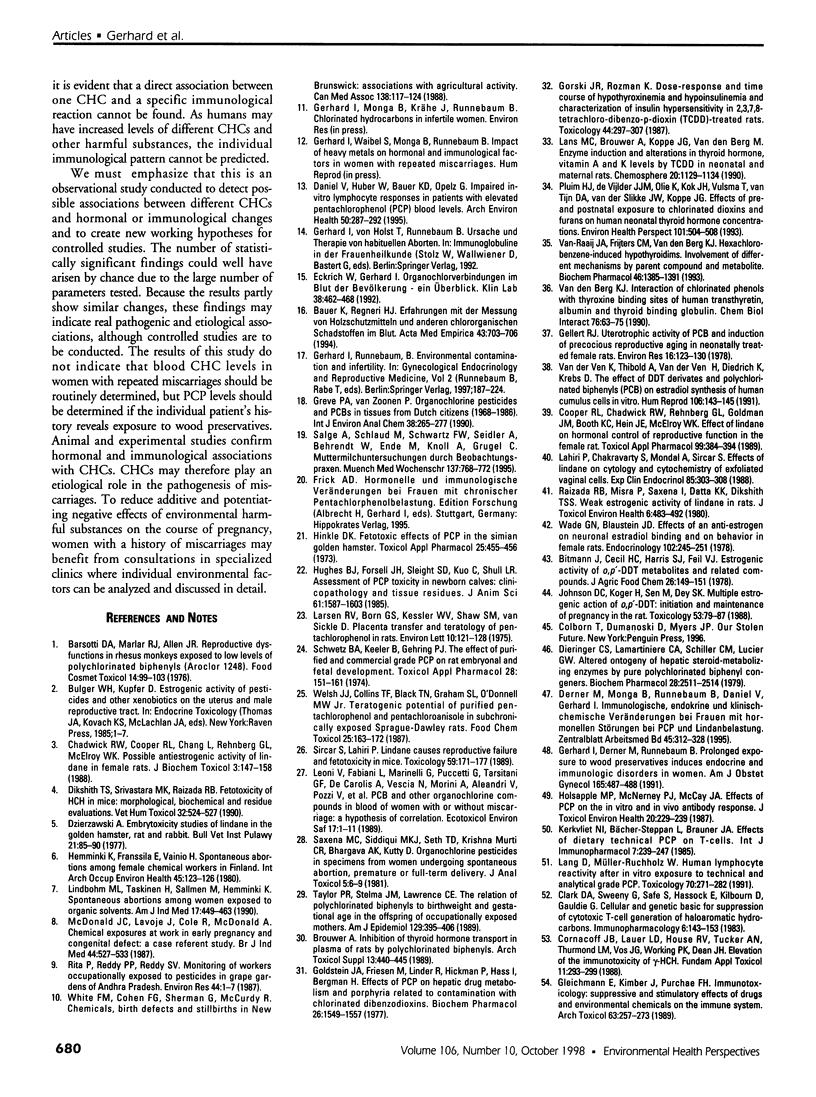
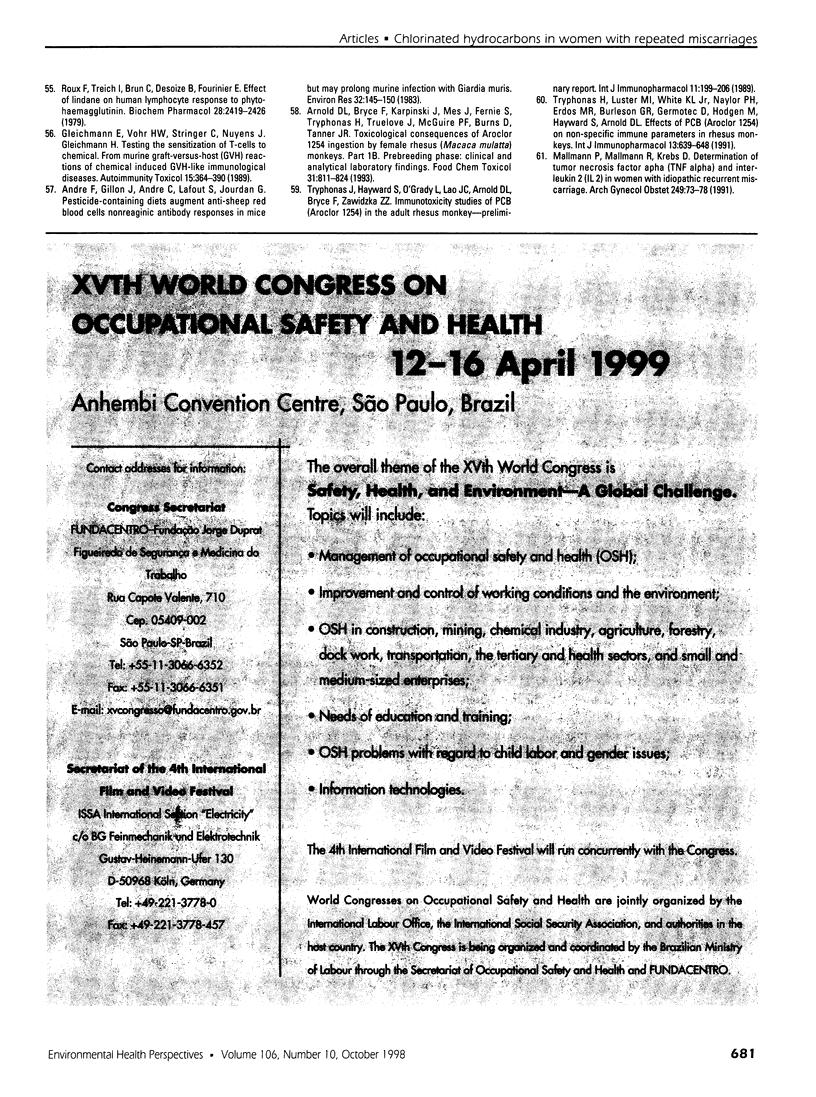
Selected References
These references are in PubMed. This may not be the complete list of references from this article.
- André F., Gillon J., André C., Lafont S., Jourdan G. Pesticide-containing diets augment anti-sheep red blood cell nonreaginic antibody responses in mice but may prolong murine infection with Giardia muris. Environ Res. 1983 Oct;32(1):145–150. doi: 10.1016/0013-9351(83)90201-3. [DOI] [PubMed] [Google Scholar]
- Arnold D. L., Bryce F., Karpinski K., Mes J., Fernie S., Tryphonas H., Truelove J., McGuire P. F., Burns D., Tanner J. R. Toxicological consequences of Aroclor 1254 ingestion by female rhesus (Macaca mulatta) monkeys. Part 1B. Prebreeding phase: clinical and analytical laboratory findings. Food Chem Toxicol. 1993 Nov;31(11):811–824. doi: 10.1016/0278-6915(93)90219-o. [DOI] [PubMed] [Google Scholar]
- Barsotti D. A., Marlar R. J., Allen J. R. Reproductive dysfunction in rhesus monkeys exposed to low levels of polychlorinated biphenyls (Aoroclor 1248). Food Cosmet Toxicol. 1976 Apr;14(2):99–103. doi: 10.1016/s0015-6264(76)80251-9. [DOI] [PubMed] [Google Scholar]
- Bitman J., Cecil H. C., Harris S. J., Feil V. J. Estrogenic activity of o,p'-DDT metabolites and related compounds. J Agric Food Chem. 1978 Jan-Feb;26(1):149–151. doi: 10.1021/jf60215a002. [DOI] [PubMed] [Google Scholar]
- Brouwer A. Inhibition of thyroid hormone transport in plasma of rats by polychlorinated biphenyls. Arch Toxicol Suppl. 1989;13:440–445. doi: 10.1007/978-3-642-74117-3_87. [DOI] [PubMed] [Google Scholar]
- Chadwick R. W., Cooper R. L., Chang J., Rehnberg G. L., McElroy W. K. Possible antiestrogenic activity of lindane in female rats. J Biochem Toxicol. 1988 Fall;3:147–158. doi: 10.1002/jbt.2570030303. [DOI] [PubMed] [Google Scholar]
- Clark D. A., Sweeney G., Safe S., Hancock E., Kilburn D. G., Gauldie J. Cellular and genetic basis for suppression of cytotoxic T cell generation by haloaromatic hydrocarbons. Immunopharmacology. 1983 Aug;6(2):143–153. doi: 10.1016/0162-3109(83)90007-3. [DOI] [PubMed] [Google Scholar]
- Cooper R. L., Chadwick R. W., Rehnberg G. L., Goldman J. M., Booth K. C., Hein J. F., McElroy W. K. Effect of lindane on hormonal control of reproductive function in the female rat. Toxicol Appl Pharmacol. 1989 Jul;99(3):384–394. doi: 10.1016/0041-008x(89)90148-8. [DOI] [PubMed] [Google Scholar]
- Cornacoff J. B., Lauer L. D., House R. V., Tucker A. N., Thurmond L. M., Vos J. G., Working P. K., Dean J. H. Evaluation of the immunotoxicity of beta-hexachlorocyclohexane (beta-HCH). Fundam Appl Toxicol. 1988 Aug;11(2):293–299. doi: 10.1016/0272-0590(88)90154-6. [DOI] [PubMed] [Google Scholar]
- Daniel V., Huber W., Bauer K., Opelz G. Impaired in-vitro lymphocyte responses in patients with elevated pentachlorophenol (PCP) blood levels. Arch Environ Health. 1995 Jul-Aug;50(4):287–292. doi: 10.1080/00039896.1995.9935956. [DOI] [PubMed] [Google Scholar]
- Dieringer C. S., Lamartiniere C. A., Schiller C. M., Lucier G. W. Altered ontogeny of hepatic steroid-metabolizing enzymes by pure polychlorinated biphenyl congeners. Biochem Pharmacol. 1979 Aug 15;28(16):2511–2514. doi: 10.1016/0006-2952(79)90016-9. [DOI] [PubMed] [Google Scholar]
- Dikshith T. S., Srivastava M. K., Raizada R. B. Fetotoxicity of hexachlorocyclohexane (HCH) in mice: morphological, biochemical and residue evaluations. Vet Hum Toxicol. 1990 Dec;32(6):524–527. [PubMed] [Google Scholar]
- Gellert R. J. Uterotrophic activity of polychlorinated biphenyls (PCB) and induction of precocious reproductive aging in neonatally treated female rats. Environ Res. 1978 Jul;16(1-3):123–130. doi: 10.1016/0013-9351(78)90149-4. [DOI] [PubMed] [Google Scholar]
- Gerhard I., Derner M., Runnebaum B. Prolonged exposure to wood preservatives induces endocrine and immunologic disorders in women. Am J Obstet Gynecol. 1991 Aug;165(2):487–488. doi: 10.1016/0002-9378(91)90131-a. [DOI] [PubMed] [Google Scholar]
- Gleichmann E., Kimber I., Purchase I. F. Immunotoxicology: suppressive and stimulatory effects of drugs and environmental chemicals on the immune system. A discussion. Arch Toxicol. 1989;63(4):257–273. doi: 10.1007/BF00278639. [DOI] [PubMed] [Google Scholar]
- Goldstein J. A., Friesen M., Linder R. E., Hickman P., Hass J. R., Bergman H. Effects of pentachlorophenol on hepatic drug-metabolizing enzymes and porphyria related to contamination with chlorinated dibenzo-p-dioxins and dibenzofurans. Biochem Pharmacol. 1977 Sep 1;26(17):1549–1557. doi: 10.1016/0006-2952(77)90068-5. [DOI] [PubMed] [Google Scholar]
- Gorski J. R., Rozman K. Dose-response and time course of hypothyroxinemia and hypoinsulinemia and characterization of insulin hypersensitivity in 2,3,7,8-tetrachlorodibenzo-p-dioxin (TCDD)-treated rats. Toxicology. 1987 Jun;44(3):297–307. doi: 10.1016/0300-483x(87)90031-x. [DOI] [PubMed] [Google Scholar]
- Hemminki K., Franssila E., Vainio H. Spontaneous abortions among female chemical workers in Finland. Int Arch Occup Environ Health. 1980 Feb;45(2):123–126. doi: 10.1007/BF01274131. [DOI] [PubMed] [Google Scholar]
- Holsapple M. P., McNerney P. J., McCay J. A. Effects of pentachlorophenol on the in vitro and in vivo antibody response. J Toxicol Environ Health. 1987;20(3):229–239. doi: 10.1080/15287398709530977. [DOI] [PubMed] [Google Scholar]
- Hughes B. J., Forsell J. H., Sleight S. D., Kuo C., Shull L. R. Assessment of pentachlorophenol toxicity in newborn calves: clinicopathology and tissue residues. J Anim Sci. 1985 Dec;61(6):1587–1603. doi: 10.2527/jas1985.6161587x. [DOI] [PubMed] [Google Scholar]
- Johnson D. C., Kogo H., Sen M., Dey S. K. Multiple estrogenic action of O,P'-DDT: initiation and maintenance of pregnancy in the rat. Toxicology. 1988 Dec 16;53(1):79–87. doi: 10.1016/0300-483x(88)90238-7. [DOI] [PubMed] [Google Scholar]
- Kerkvliet N. I., Brauner J. A., Baecher-Steppan L. Effects of dietary technical pentachlorophenol exposure on T cell, macrophage and natural killer cell activity in C57Bl/6 mice. Int J Immunopharmacol. 1985;7(2):239–247. doi: 10.1016/0192-0561(85)90032-3. [DOI] [PubMed] [Google Scholar]
- Lahiri P., Chakravarty S., Mondal A., Sircar S. Effect of lindane on cytology and cytochemistry of exfoliated vaginal cells. Exp Clin Endocrinol. 1985 Jun;85(3):303–308. doi: 10.1055/s-0029-1210454. [DOI] [PubMed] [Google Scholar]
- Lang D., Mueller-Ruchholtz W. Human lymphocyte reactivity after in vitro exposure to technical and analytical grade pentachlorophenol. Toxicology. 1991;70(3):271–282. doi: 10.1016/0300-483x(91)90002-i. [DOI] [PubMed] [Google Scholar]
- Larsen R. V., Born G. S., Kessler W. V., Shaw S. M., Van Sickel D. C. Placental transfer and teratology of pentachlorophenol in rats. Environ Lett. 1975;10(2):121–128. doi: 10.1080/00139307509435815. [DOI] [PubMed] [Google Scholar]
- Leoni V., Fabiani L., Marinelli G., Puccetti G., Tarsitani G. F., De Carolis A., Vescia N., Morini A., Aleandri V., Pozzi V. PCB and other organochlorine compounds in blood of women with or without miscarriage: a hypothesis of correlation. Ecotoxicol Environ Saf. 1989 Feb;17(1):1–11. doi: 10.1016/0147-6513(89)90002-x. [DOI] [PubMed] [Google Scholar]
- Lindbohm M. L., Taskinen H., Sallmén M., Hemminki K. Spontaneous abortions among women exposed to organic solvents. Am J Ind Med. 1990;17(4):449–463. doi: 10.1002/ajim.4700170404. [DOI] [PubMed] [Google Scholar]
- Mallmann P., Mallmann R., Krebs D. Determination of tumor necrosis factor alpha (TNF alpha) and interleukin 2 (IL 2) in women with idiopathic recurrent miscarriage. Arch Gynecol Obstet. 1991;249(2):73–78. doi: 10.1007/BF02390365. [DOI] [PubMed] [Google Scholar]
- McDonald J. C., Lavoie J., Côté R., McDonald A. D. Chemical exposures at work in early pregnancy and congenital defect: a case-referent study. Br J Ind Med. 1987 Aug;44(8):527–533. doi: 10.1136/oem.44.8.527. [DOI] [PMC free article] [PubMed] [Google Scholar]
- Pluim H. J., de Vijlder J. J., Olie K., Kok J. H., Vulsma T., van Tijn D. A., van der Slikke J. W., Koppe J. G. Effects of pre- and postnatal exposure to chlorinated dioxins and furans on human neonatal thyroid hormone concentrations. Environ Health Perspect. 1993 Nov;101(6):504–508. doi: 10.1289/ehp.93101504. [DOI] [PMC free article] [PubMed] [Google Scholar]
- Raizada R. B., Misra P., Saxena P., Datta K. K., Dikshith T. S. Weak estrogenic activity of lindane in rats. J Toxicol Environ Health. 1980 May;6(3):483–492. doi: 10.1080/15287398009529867. [DOI] [PubMed] [Google Scholar]
- Rita P., Reddy P. P., Reddy S. V. Monitoring of workers occupationally exposed to pesticides in grape gardens of Andhra Pradesh. Environ Res. 1987 Oct;44(1):1–5. doi: 10.1016/s0013-9351(87)80081-6. [DOI] [PubMed] [Google Scholar]
- Roux F., Treich I., Brun C., Desoize B., Fournier E. Effect of lindane on human lymphocyte responses to phytohemagglutinin. Biochem Pharmacol. 1979 Aug 15;28(16):2419–2426. doi: 10.1016/0006-2952(79)90002-9. [DOI] [PubMed] [Google Scholar]
- Saxena M. C., Siddiqui M. K., Seth T. D., Krishna Murti C. R., Bhargava A. K., Kutty D. Organochlorine pesticides in specimens from women undergoing spontaneous abortion, premature of full-term delivery. J Anal Toxicol. 1981 Jan-Feb;5(1):6–9. doi: 10.1093/jat/5.1.6. [DOI] [PubMed] [Google Scholar]
- Schwetz B. A., Keeler P. A., Gehring P. J. The effect of purified and commercial grade pentachlorophenol on rat embryonal and fetal development. Toxicol Appl Pharmacol. 1974 Apr;28(1):151–161. doi: 10.1016/0041-008x(74)90141-0. [DOI] [PubMed] [Google Scholar]
- Sircar S., Lahiri P. Lindane (gamma-HCH) causes reproductive failure and fetotoxicity in mice. Toxicology. 1989 Dec 1;59(2):171–177. doi: 10.1016/0300-483x(89)90055-3. [DOI] [PubMed] [Google Scholar]
- Taylor P. R., Stelma J. M., Lawrence C. E. The relation of polychlorinated biphenyls to birth weight and gestational age in the offspring of occupationally exposed mothers. Am J Epidemiol. 1989 Feb;129(2):395–406. doi: 10.1093/oxfordjournals.aje.a115143. [DOI] [PubMed] [Google Scholar]
- Tryphonas H., Hayward S., O'Grady L., Loo J. C., Arnold D. L., Bryce F., Zawidzka Z. Z. Immunotoxicity studies of PCB (Aroclor 1254) in the adult rhesus (Macaca mulatta) monkey--preliminary report. Int J Immunopharmacol. 1989;11(2):199–206. doi: 10.1016/0192-0561(89)90072-6. [DOI] [PubMed] [Google Scholar]
- Tryphonas H., Luster M. I., White K. L., Jr, Naylor P. H., Erdos M. R., Burleson G. R., Germolec D., Hodgen M., Hayward S., Arnold D. L. Effects of PCB (Aroclor 1254) on non-specific immune parameters in rhesus (Macaca mulatta) monkeys. Int J Immunopharmacol. 1991;13(6):639–648. doi: 10.1016/0192-0561(91)90176-8. [DOI] [PubMed] [Google Scholar]
- Wade G. N., Blaustein J. D. Effects of an anti-estrogen on neural estradiol binding and on behaviors in female rats. Endocrinology. 1978 Jan;102(1):245–251. doi: 10.1210/endo-102-1-245. [DOI] [PubMed] [Google Scholar]
- Welsh J. J., Collins T. F., Black T. N., Graham S. L., O'Donnell M. W., Jr Teratogenic potential of purified pentachlorophenol and pentachloroanisole in subchronically exposed Sprague-Dawley rats. Food Chem Toxicol. 1987 Feb;25(2):163–172. doi: 10.1016/0278-6915(87)90150-5. [DOI] [PubMed] [Google Scholar]
- White F. M., Cohen F. G., Sherman G., McCurdy R. Chemicals, birth defects and stillbirths in New Brunswick: associations with agricultural activity. CMAJ. 1988 Jan 15;138(2):117–124. [PMC free article] [PubMed] [Google Scholar]
- van Raaij J. A., Frijters C. M., van den Berg K. J. Hexachlorobenzene-induced hypothyroidism. Involvement of different mechanisms by parent compound and metabolite. Biochem Pharmacol. 1993 Oct 19;46(8):1385–1391. doi: 10.1016/0006-2952(93)90103-4. [DOI] [PubMed] [Google Scholar]
- van den Berg K. J. Interaction of chlorinated phenols with thyroxine binding sites of human transthyretin, albumin and thyroid binding globulin. Chem Biol Interact. 1990;76(1):63–75. doi: 10.1016/0009-2797(90)90034-k. [DOI] [PubMed] [Google Scholar]


